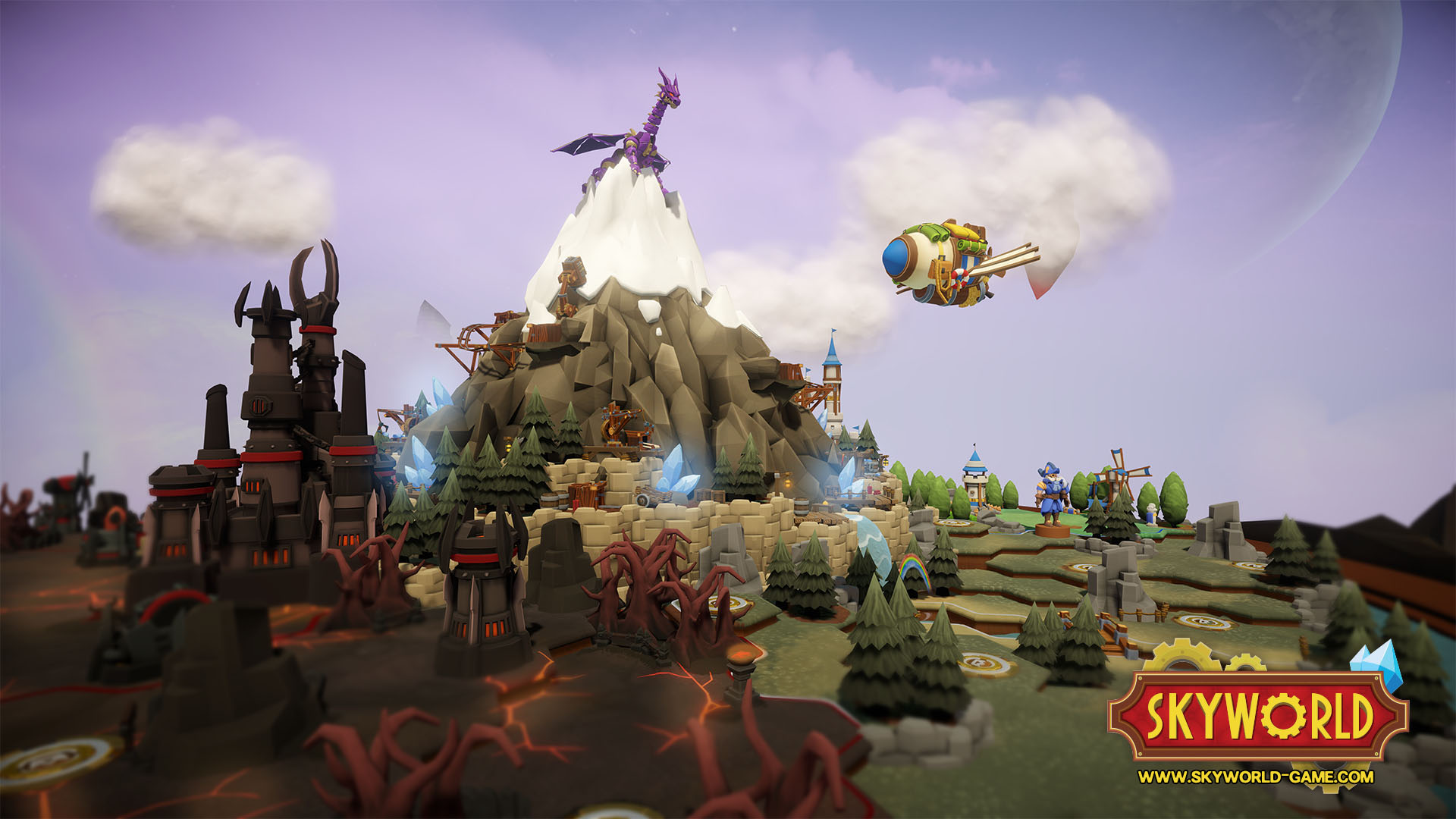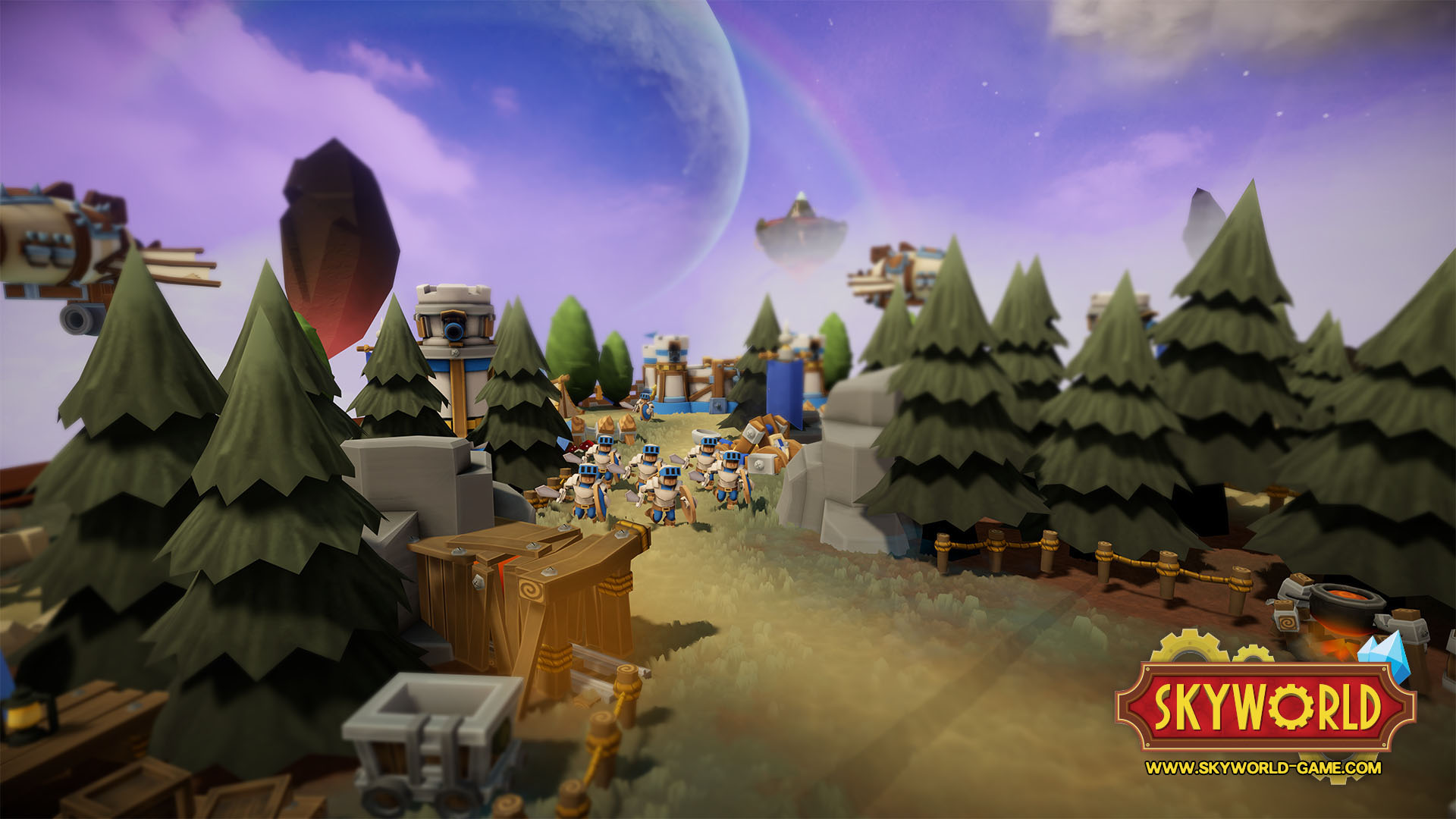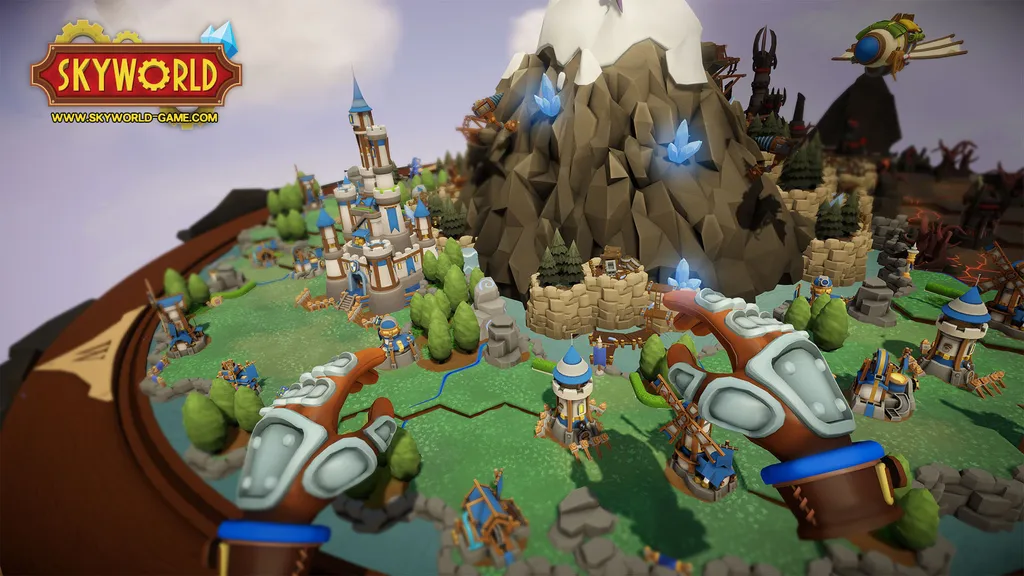It seems like every other game released for VR is a wave shooter, so as a fan of myriad genres – and particularly strategy games — I was excited to jump into Vertigo Games’ Skyworld and take a spin.
Most of Skyworld plays out on the overworld map as a turn-based board game. The setup is pretty standard: manage and gather resources such as iron, wood, stone and magic to build and upgrade an army and ultimately defeat the invading demons. The heart of your kingdom is the castle, which you can upgrade to add better defense and put more generals on the map to take over more regions and challenge opponents.
The large, circular fantasy map is bright, colorful, cute and charming, and you can navigate around the board by turning it like a giant ship’s wheel. Trees and other objects bend and undulate when you pass your hand through them, but with the exception of moving generals around the map and dropping resource buildings at set points, interaction with the overworld is pretty light.
Each map is divided into a number of small fiefdoms which you can take control of by building a watchtower. These regions of influence grant you more building spots and, as long as you’re next to one, prevent you from incurring a disadvantage from being too far away from your homeland.
The action changes from turn-based to real-time when you move your general onto an enemy general, castle or watchtower. Battle setup is very similar to Clash Royale where each opposing general has two towers flanking a central castle. You can pick units to send up one of three lanes that lead into enemy territory, and if you can cross the center point, a floating cannon balloon spawns to take aim at the opposing towers and eventually the castle once the towers are destroyed. You also have a number of spells that you can cast across the entire map which cause a variety of effects such as area damage, freezing enemy units or boasting your own units’ abilities.
You can pick eight of the 20 units available by the end of the game, which vary from melee, range and area of effect, and come in both ground and air types. Overall though, the strategy in the game is very light as there’s not a lot of variety in the units and you can’t directly control what they do or where they go after you choose the initial path, which you can alter slightly with a twist of your wrist. And whereas the overworld map is cute and charming, that same aesthetic doesn’t carry over to the units as none are really that interesting or appealing, even the gearworks dragon.
While the objectives change slightly – attack this castle, control this region, etc. — the action in Skyworld tends to get repetitive, and you’ll play with the same units over and over again in early in the game as you don’t really start unlocking a wide variety until halfway through the campaign. And even then, you usually don’t keep your units from the previous mission, so you have to build everything up again from scratch. It’s a bit of a trudge and doesn’t give a sense that all your hard work and kingdom building amounted to much.

Like the overworld, the interface is cute and charming, and the wooden levers, plungers and buttons fit the fantasy theme perfectly. You can keep frequent controls like building types and resource tallies literally at an arms-length away on floating wooden tablets surrounding you as you peer down at the round overworld. To get to various game options like buying new unit cards and upgrading units you literally flip the table with the pull of a lever. However, what is a neat effect the first few times gets annoying after a while as table turning makes navigation more tedious and time-consuming than it has to be, especially when options such as tax and food distribution rate could have been easily been integrated into a menu overlay like so many other oft-used settings.
The table and floating menu controls are also a little finicky, and I accidently moved the table on more than one occasion when I was reaching for a tablet floating nearby. Although you can stand and play, I mainly played Skyworld seated and had to struggle occasionally to move the table to the position I wanted as it seemed to lock at certain elevations and would just spin when I wanted to move the entire table up, down or closer to me.
Most of the options in the overworld are seamless, but Skyworld does have to pause and load when you go to battle, which is preceded by the ubiquitous table flip. Neither is necessarily bad, but having to wait for the table to flip only to then pause again for the battle map to load detracts from the experience and immersiveness. I also encountered erratic table jumping right before loading from overworld to battle map, which was disorienting in VR to say the least as the entire scene would jitter for a second or so.
I also ran into a strange bug while playing that randomly and automatically bumped my difficulty level to Insane when I was playing a campaign on Normal. I was wondering why the game got really tough all of a sudden, and when I looked at my autosaves from the past few sessions, I saw I was locked on Insane. I didn’t remember changing the difficulty, so I reloaded my previous game and was able to replicate. It was annoying and there was no cue as to why or what had happened, so I just had to do my best on Insane difficulty until I got to a new mission — which also started on Insane — then quit and start that mission anew from the menu.

Now I’m fine with a good challenge, but higher difficulty in Skyworld doesn’t mean better AI, it just comes down to your computer-controlled opponent cheating with seemingly unlimited resources, mana spam and higher-level units than should be available; even at higher difficulty levels the game should stay true to itself and its own rules. Get smarter, not dodgier.
Skyworld consists of eight missions and you can likely get through them all in about 8 to 12 hours, depending on difficulty level. You can also opt to play a quick skirmish on one of the various maps or jump into online multiplayer where you can set the time per round to speed the game along. However, since VR is still rather niche, finding a random multiplayer match is often impossible, so it’s best to have a mate who also owns the game if you’re looking to take on a human opponent.
I enjoyed much of the time I spent with Skyworld, but it has some big problems, and I probably won’t play again, at least not any time soon. Skyworld has some good ideas, but ultimately its full potential is unrealized. I applaud Vertigo for trying something new, but when it comes down to it, VR doesn’t really enhance a board game and simple strategy experience like this, and it often became more tedious and convoluted than fun.
Editor’s Note 10/27/2017: Added clarification that, while you can’t change a unit’s movement once the card is played, you can slightly alter the initial pathing with a twist of your wrist.
Skyworld is now available on HTC Vive, Oculus Rift and Windows Mixed Reality. Check out our review guidelines to find out more about our process.
























